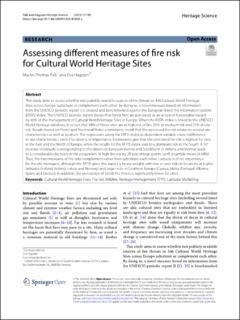Assessing different measures of fire risk for Cultural World Heritage Sites
Peer reviewed, Journal article
Published version
Permanent lenke
https://hdl.handle.net/11250/3123563Utgivelsesdato
2023Metadata
Vis full innførselSamlinger
- Institutt for økonomi og it [152]
- Publikasjoner fra CRIStin [3438]
Originalversjon
Falk, M. T., & Hagsten, E. (2023). Assessing different measures of fire risk for Cultural World Heritage Sites. Heritage Science, 11(1), Artikkel 189. https://doi.org/10.1186/s40494-023-01026-ySammendrag
This study aims to assess whether two publicly available sources of fire threats to 346 Cultural World Heritage Sites across Europe substitute or complement each other. By doing so, a novel measure based on information from the UNESCO periodic report II is created and benchmarked against the European forest fire information system (EFFIS) index. The UNESCO periodic report shows that forest fires are perceived as an actual or foreseeable hazard by 40% of the management of Cultural World Heritage Sites in Europe. When the EFFIS index is linked to the UNESCO World Heritage database, it occurs that 48% of these sites are at high risk of fire, 31% at medium risk and 21% at low risk. Results based on Probit and Fractional Probit estimations reveal that the perceived fire risk relates to several site characteristics as well as location. The regressions using the EFFIS index as dependent variable show indifference to site characteristics even if location is of importance. Estimations give that the perceived fire risk is highest for sites in the East and the North of Europe, while the results for the EFFIS index lead to a dominant risk in the South. A 10° increase in latitude (corresponding to the distances between Vienna and Stockholm or Athens and Vienna) leads to a considerable decrease in the proportion of high fire risk by 28 percentage points (with a sample mean of 48%). Thus, the two measures of fire risks complement rather than substitute each other. Latitude is of no importance for the site managers, although the EFFIS gives this aspect a heavy weight, with low or zero risks in locations at higher latitudes (Iceland, Ireland, Latvia, and Norway) and larger risks in Southern Europe (Cyprus, Malta, Portugal, Albania, Spain, and Greece). In addition, the perception of (wild)-fire threat is significantly lower for cities. Assessing different measures of fire risk for Cultural World Heritage Sites

